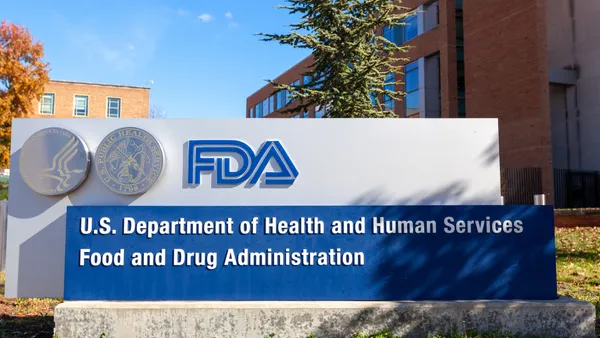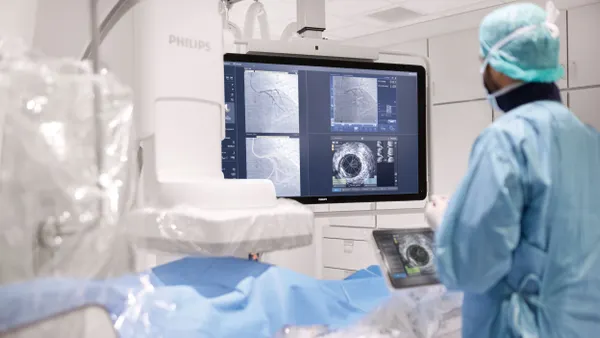Dive Brief:
- Edwards Lifesciences' revenue for the fourth quarter fell slightly below expectations as the company sold fewer transcatheter aortic valve replacement (TAVR) devices than expected. Its stock was trading down 4% on Thursday.
- Company leadership said the delays were primarily due to hospital staffing and capacity, as the omicron variant swept the U.S. at the end of 2021. "We saw a very strong impact in December," Edwards CEO Mike Mussallem said during a Wednesday investor call. "It was primarily focused in the U.S. and it was centered around hospital capacity. They really reached their limits in many cases and started deferring procedures. We've seen that continue to lead to a slow start in 2022."
- In spite of that, the company is keeping its recent 2022 revenue guidance between $5.5 billion and $6 billion, an increase in the low double-digits from last year.
Dive Insight:
The latest surge in COVID-19 cases hit procedure-dependent device companies, and Edwards was no exception. The Irvine, Calif.-based company saw sales of its lead business fall slightly below expectations as more hospitals deferred TAVR procedures at the end of 2021. However, it provided a rosier outlook than others for the rest of 2022.
Edwards is positioned a little bit differently than some of the medtechs that have reported so far this quarter. Its transcatheter devices to treat heart valve disease might be prioritized over other procedures deemed by some as more elective during the pandemic, which has especially hit orthopaedic procedures. Medtronic, which produces a competing TAVR system, will report earnings later in February.
All the same, Edwards still saw some procedures delayed at the end of the year as hospital staffing shortages worsened. Sales of TAVR devices, at $872 million, were up 12% compared to the fourth quarter of 2020, falling below Wall Street's expectations of a 14% increase.
Earlier this month, analysts with Jeffries warned that TAVR sales might be lagging behind, based on early U.S. data.
Analysts with BTIG on Wednesday described the slowdown as a "temporary blip," expecting TAVR sales to recover in 2022. Mussallem hesitated to forecast a sudden rebound in procedures like seen in the summer of 2021, expecting a more gradual recovery.
"At this point, we assume that many of the patients that are having procedures postponed or deferred are going to come back," the CEO said.
Another big area of focus for the company is transcatheter procedures for the mitral and tricuspid valves (TMTT). It's a much smaller, but fast-growing part of Edwards' business, bringing in $25 million in revenue for the quarter, nearly double that of last year.
For the full-year 2022, Edwards expects the segment to bring in between $140 million and $170 million in revenue, a roughly 80% increase from 2021 at the midpoint.
The company finished enrollment for a pivotal trial of its Pascal valve system in the fourth quarter. That would put it on track to present data in the second half of this year, and for FDA approval by the end of the year, Mussallem said. In Europe, the company is also expecting approval of its newest Pascal precision system later this year.
Analysts with Stifel wrote in a research note that while Edwards isn't projecting significant 2022 sales in the U.S. for its Pascal device, "our sense is that they see a potentially meaningful step up in 2023."
They noted that Edwards is not only preparing for the launch of the device, but the expansion of the TMTT market as a whole.
In total, Edwards brought in revenues of $5.2 billion, up 19% from 2020. The mark also surpassed 2019 revenues, before the pandemic upended normal procedure patterns. The company's net income of $1.5 billion in 2021 also increased from $823 million the prior year.
The company is seeing an uptick in expenses, as it puts more money into research and development, and also navigates inflation in wages, materials and supplies.
Despite a challenging start to 2022, Edwards expects to meet its previously set revenue guidance of $5.5 billion to $6 billion for 2022. For the first quarter, the company forecasted revenue between $1.27 billion and $1.35 billion.
"At this point, I would say sales are below what we would have typically expected for a start; probably more in line with the kind of thing that we saw toward the end of December," Mussallem said. "But having said that, our assumptions are that we're going to see more normalized growth as the hospital resource constraints stabilize."












